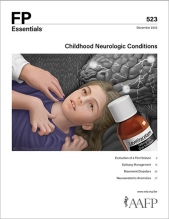
This clinical content conforms to AAFP criteria for CME.
Seizure is one of the most common neurologic conditions in children, occurring most often in the first year of life. Identification of provoking factors, such as fever, illness, head trauma, electrolyte disturbance, or central nervous system infection, is important for determining prognosis and likelihood of recurrence. In patients presenting with a suspected first seizure, a history should be taken and a neurologic examination performed to determine whether the event was a seizure. If seizure is confirmed, it should be determined whether it was a first seizure and was provoked or unprovoked. The final step is to determine the cause. For children who present with simple febrile seizures, no additional evaluation typically is needed. An electroencephalogram performed during wakefulness and sleep is recommended for children with a first unprovoked seizure. For children with new-onset seizures, particularly focal seizures or status epilepticus, neuroimaging with magnetic resonance imaging study is recommended. Most children will have only a single seizure, whereas a small number will develop epilepsy. Risk factors for epilepsy development include a history of febrile seizures, status epilepticus, a family history of epilepsy, developmental delay, and abnormal neurologic examination results.
Case 1. CR is a 2-year-old boy with a history of recurrent otitis media who is brought to the emergency department after a seizure. His parents say he was not feeling well before the seizure. They report having heard a strange gurgling sound on the baby monitor, and when they checked, CR was having a convulsion that affected his whole body and lasted 2 minutes. CR currently is tired and fussy. The physical examination is notable for otitis media of the right ear and a fever of 102°F (38.9°C).
Subscribe
From $350- Immediate, unlimited access to FP Essentials content
- 60 CME credits/year
- AAFP app access
- Print delivery available
Edition Access
$44- Immediate, unlimited access to this edition's content
- 5 CME credits
- AAFP app access
- Print delivery available
